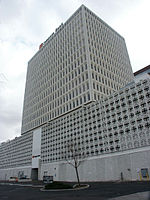W. E. Mauger House

The W. E. Mauger House is a historic Queen Anne style home in Albuquerque, New Mexico. It was built around 1896 by Maude Goodlander and Martha Talbott, but is most closely associated with William and Brittania Mauger, who owned it from 1907 to 1932. Later, it was converted into a boarding house and remained in use as rental housing until the 1980s. Starting in 1985, the building was restored to its original appearance and has operated as a bed and breakfast since 1987. It is a 2 1/2 story brick house with a hip roof, asymmetrical front elevation with a large entrance porch, and a two-level sleeping porch on the west side. The house was added to the New Mexico State Register of Cultural Properties and the National Register of Historic Places in 1985 as "701 Roma NW".
Excerpt from the Wikipedia article W. E. Mauger House (License: CC BY-SA 3.0, Authors, Images).W. E. Mauger House
6th Street Northwest, Albuquerque Downtown Albuquerque
Geographical coordinates (GPS) Address Nearby Places Show on map
Geographical coordinates (GPS)
| Latitude | Longitude |
|---|---|
| N 35.089722222222 ° | E -106.65388888889 ° |
Address
Lew Wallace Elementary School
6th Street Northwest 513
87102 Albuquerque, Downtown Albuquerque
New Mexico, United States
Open on Google Maps










